
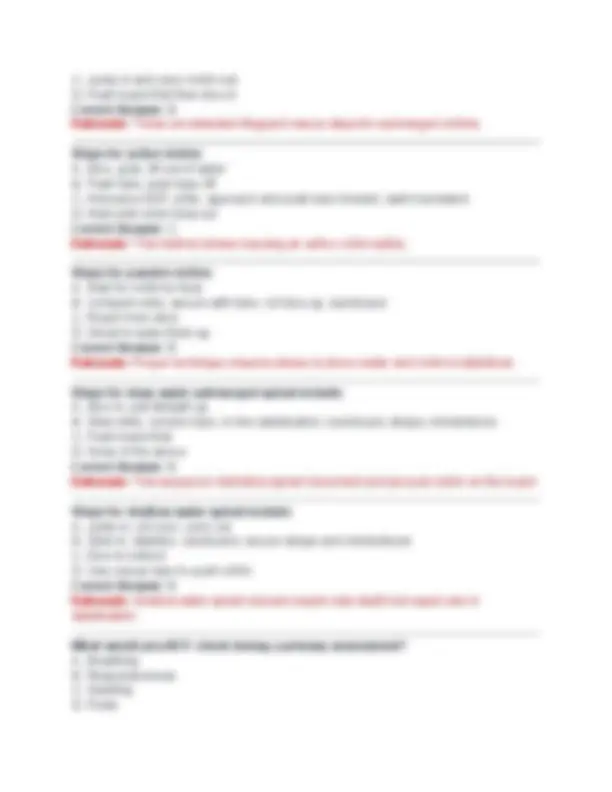
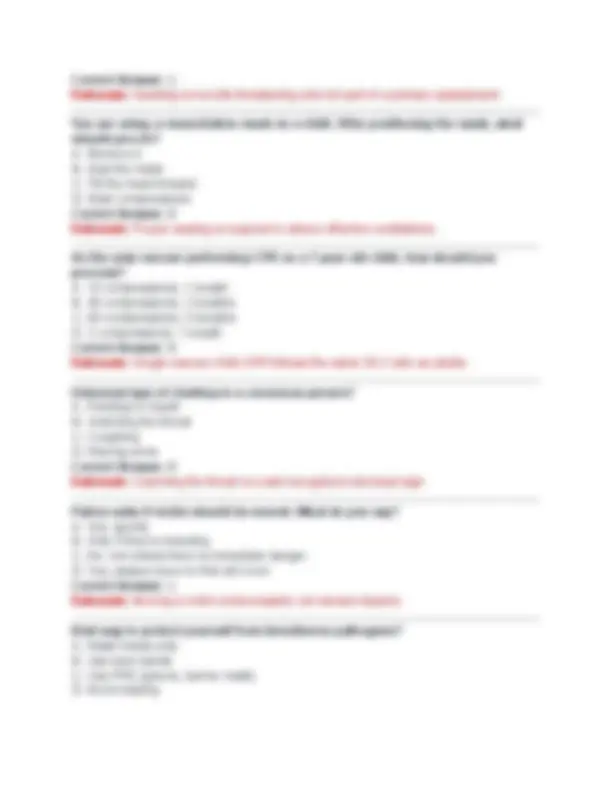
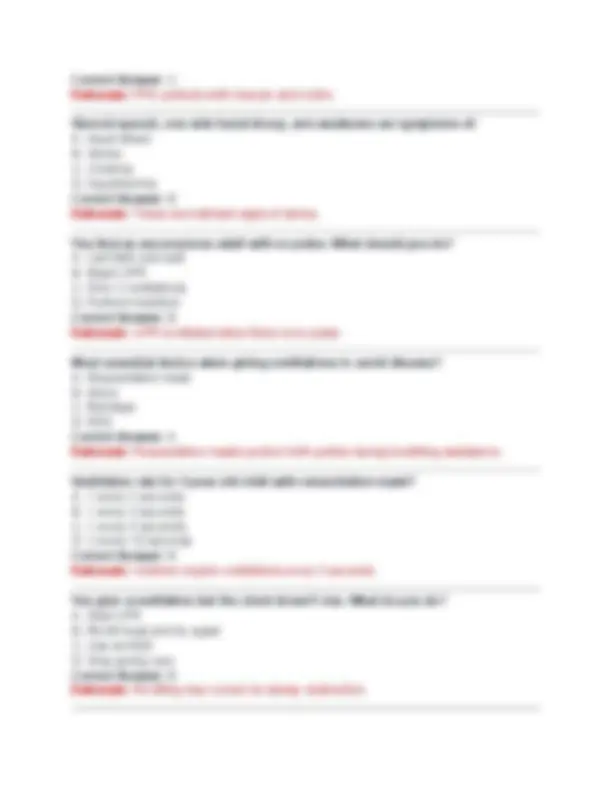
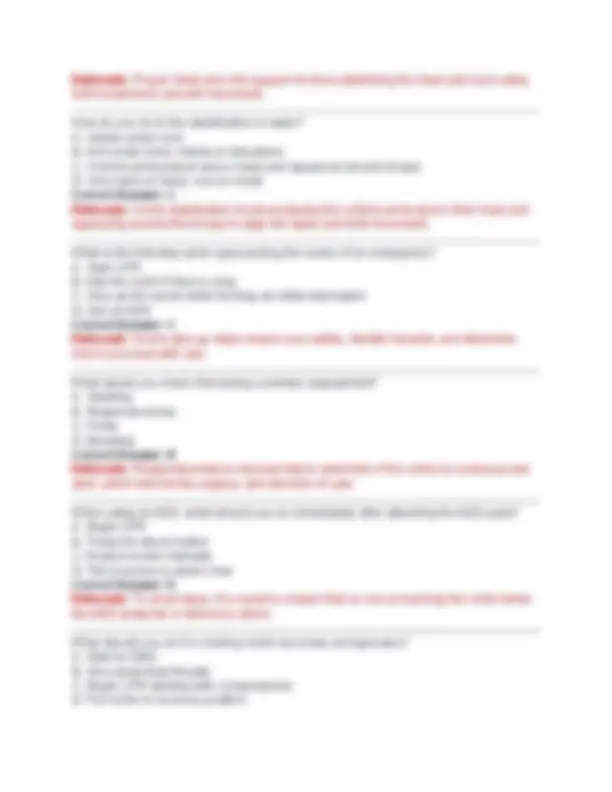
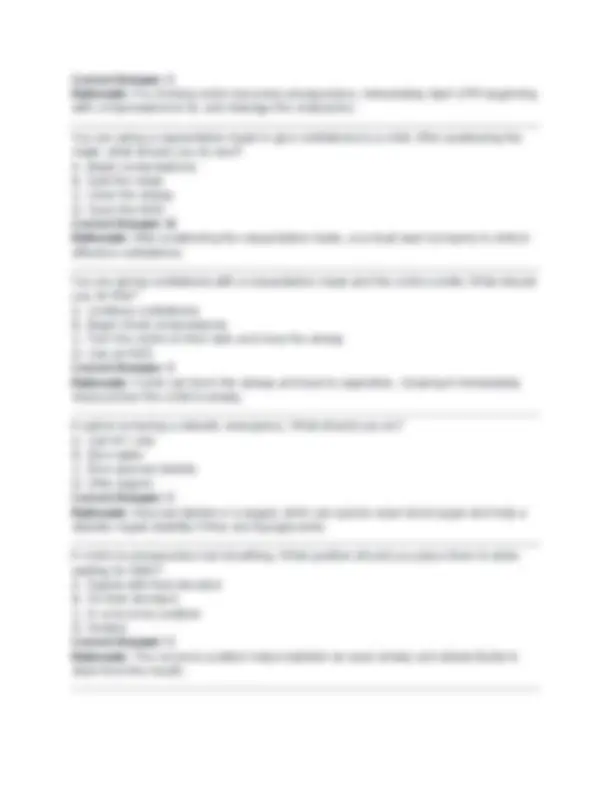
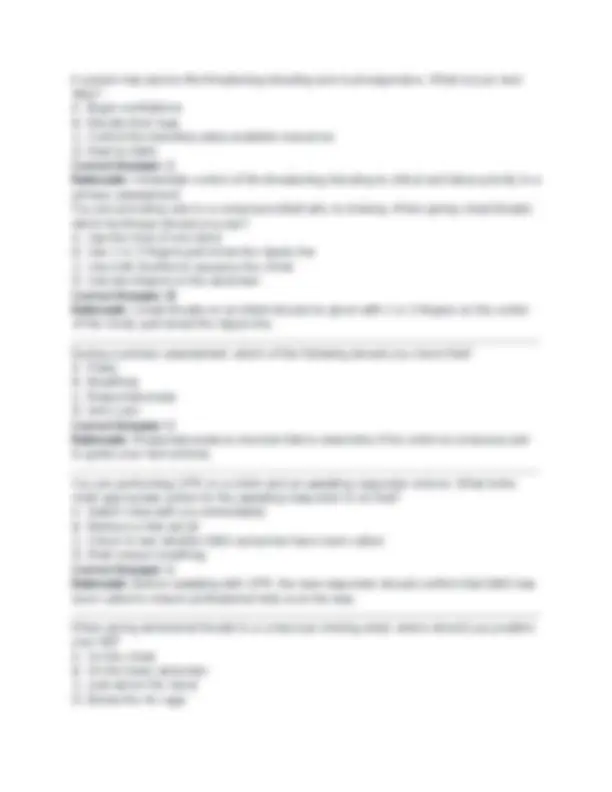
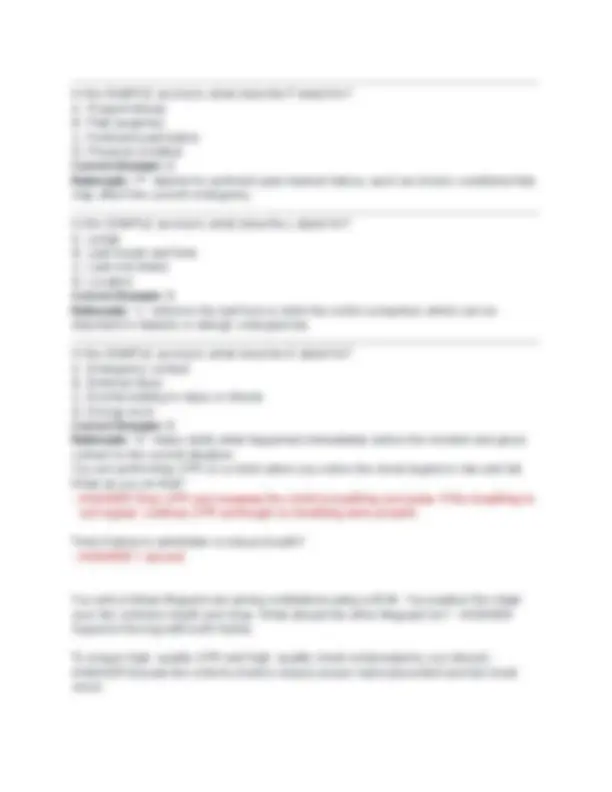
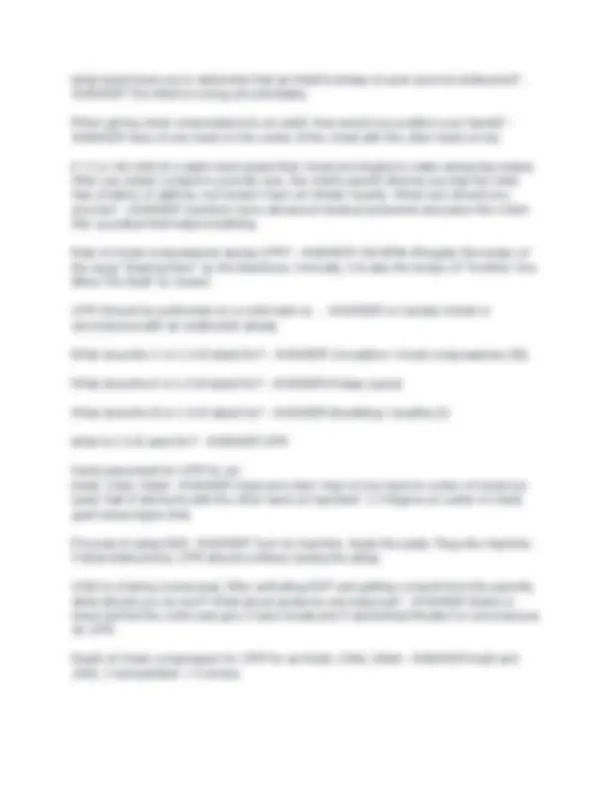
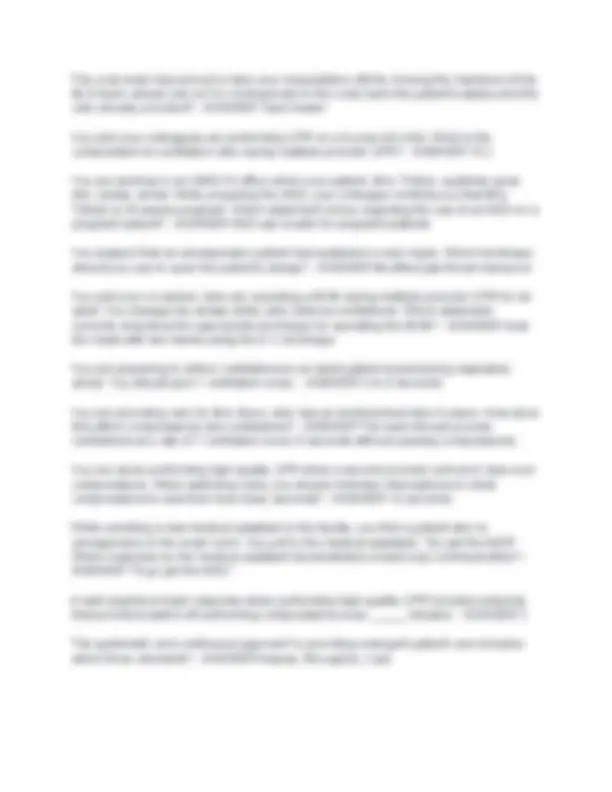
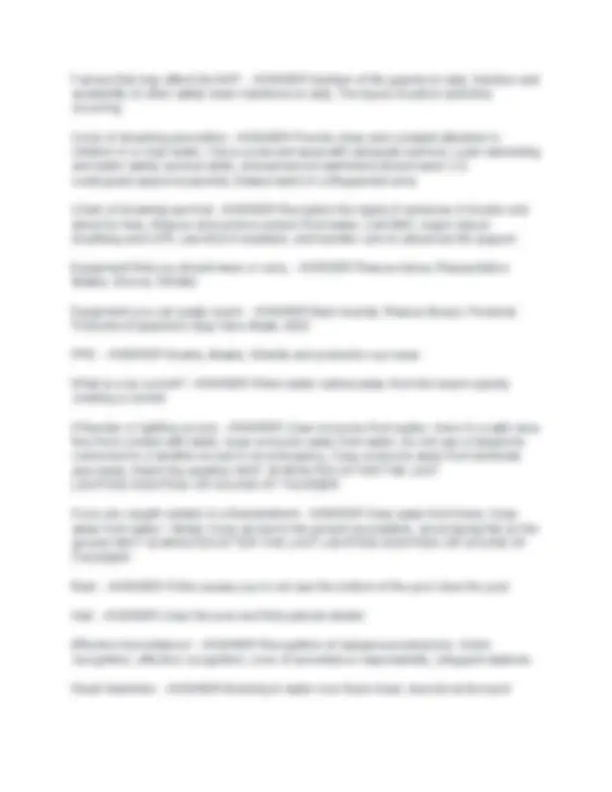
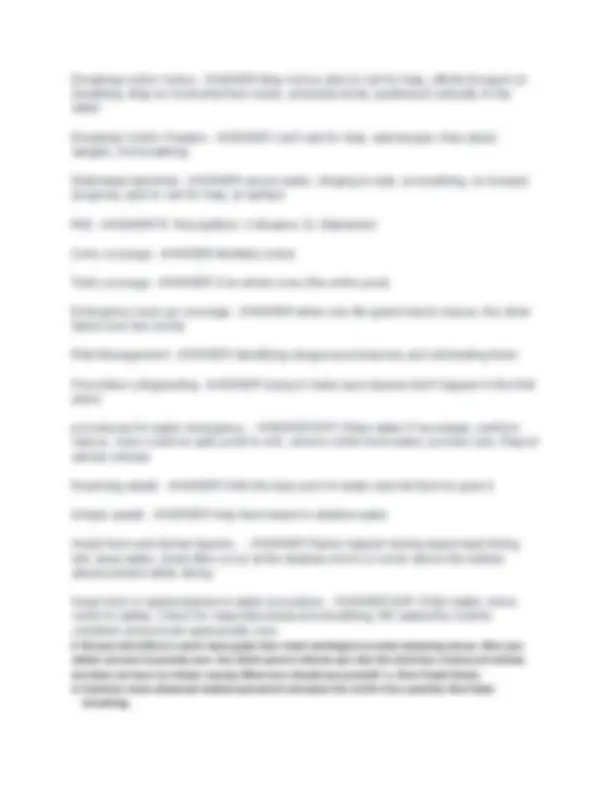
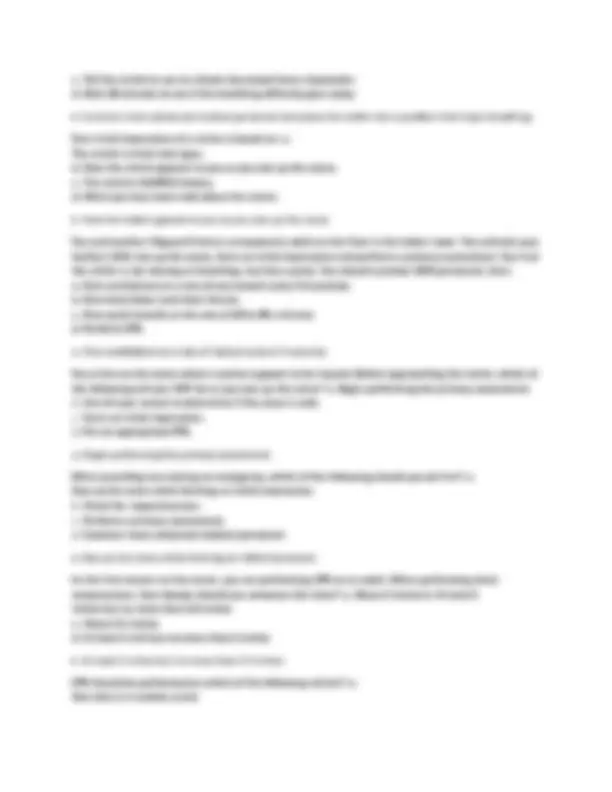
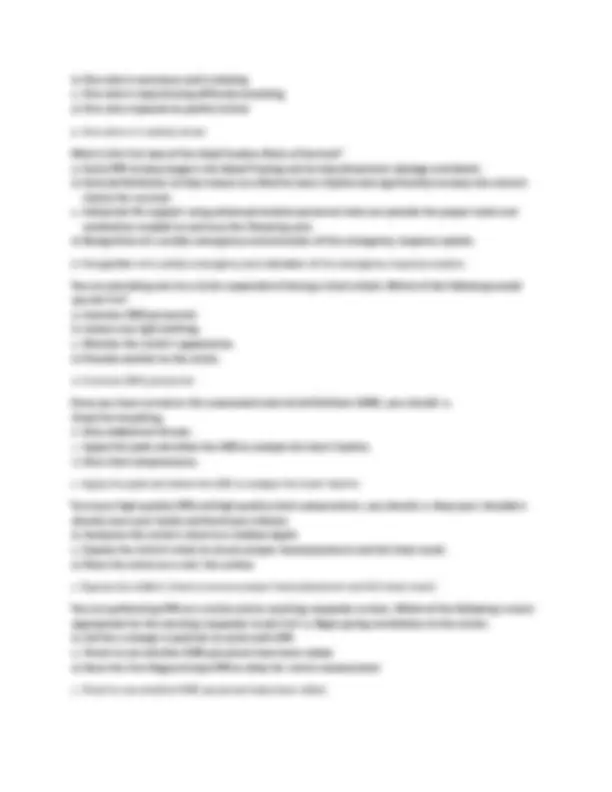
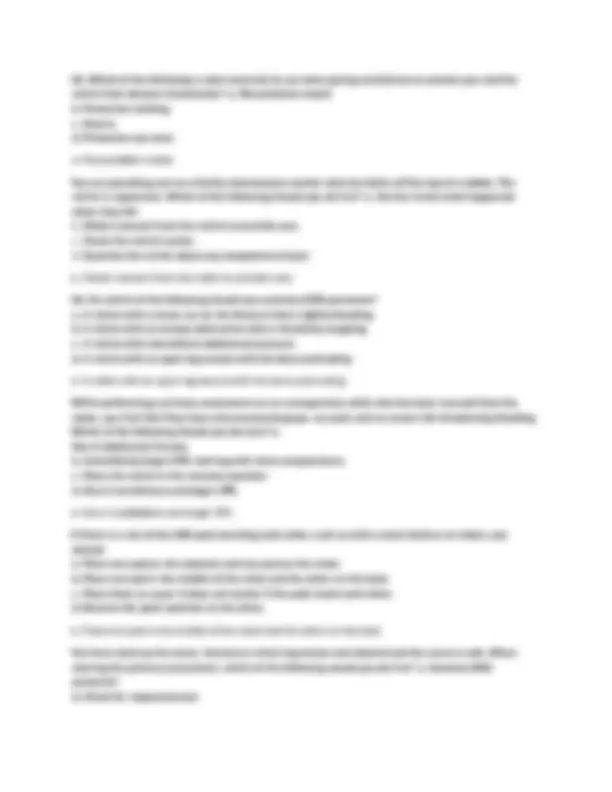
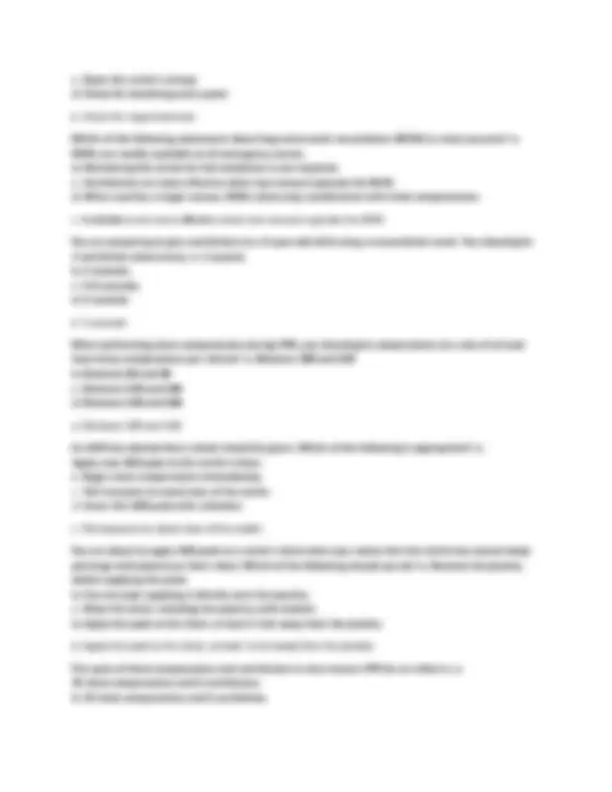
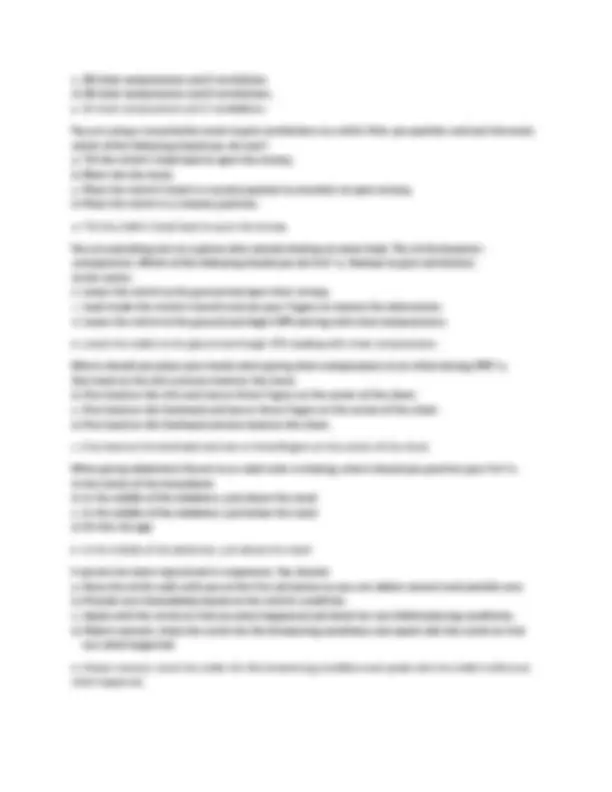
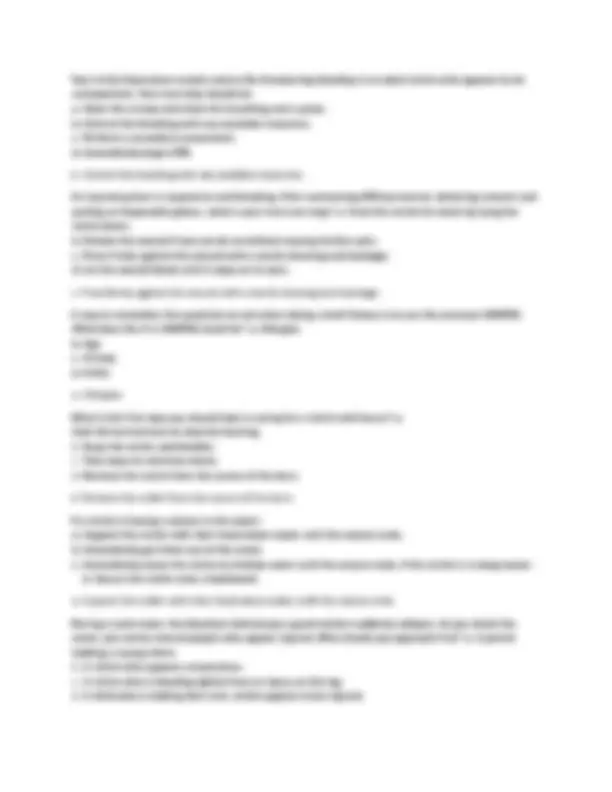
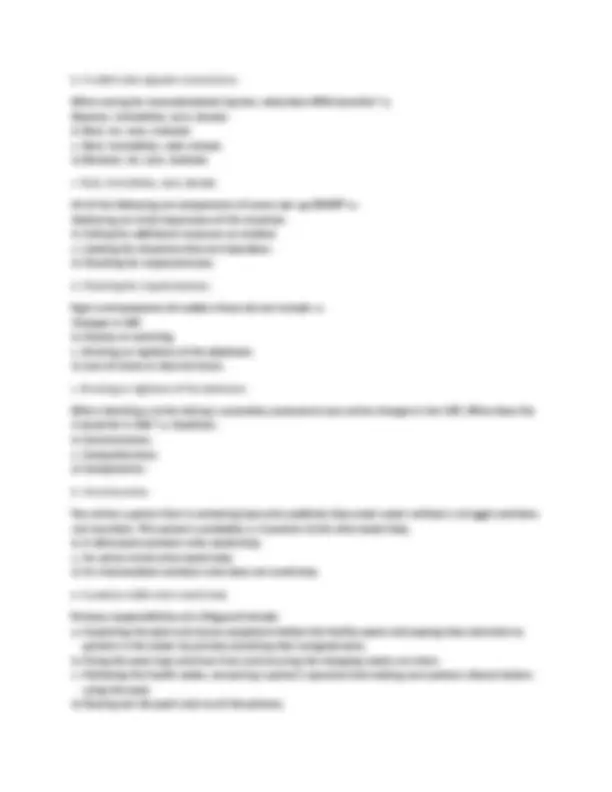
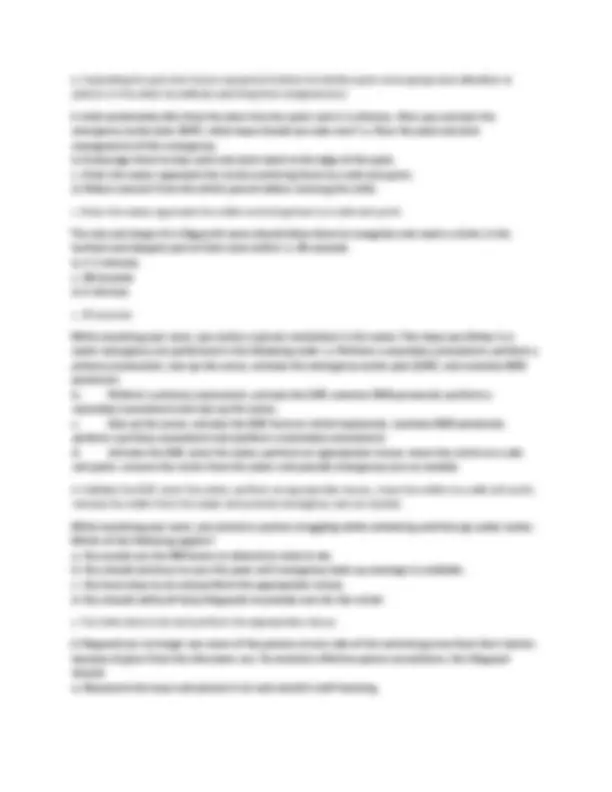
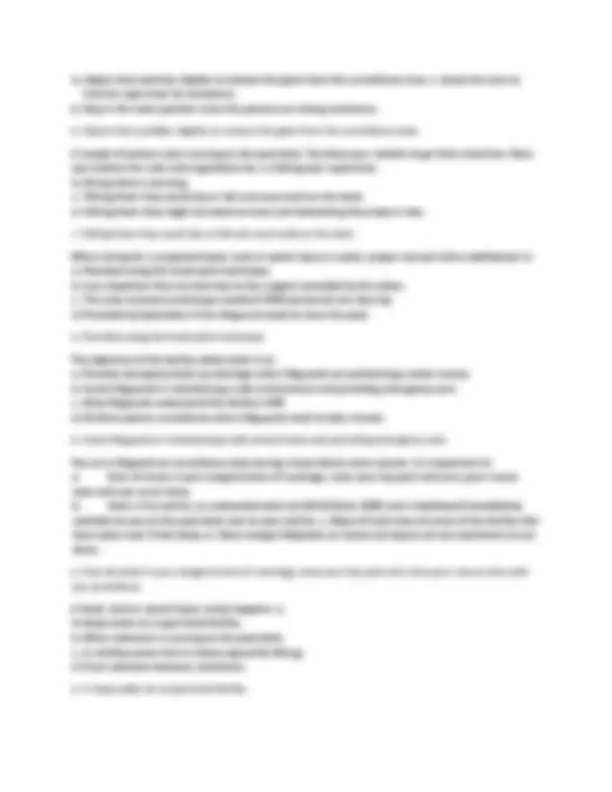
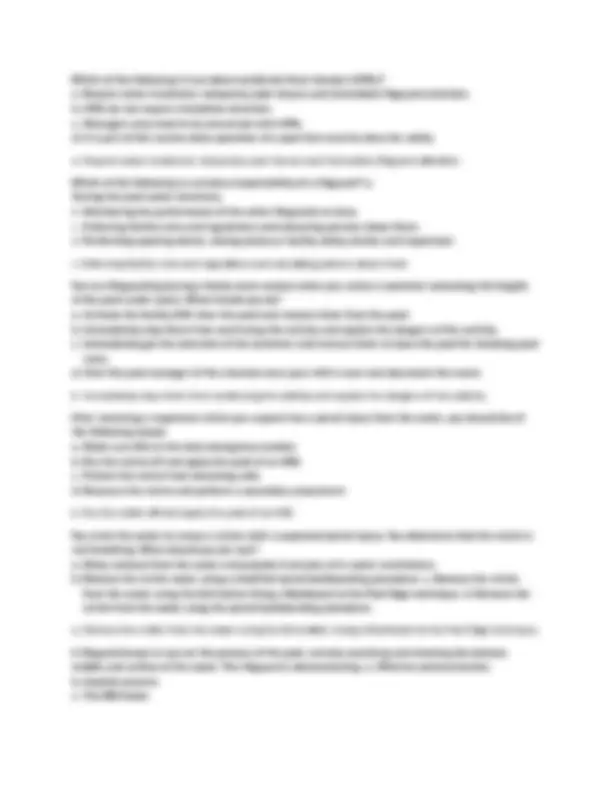
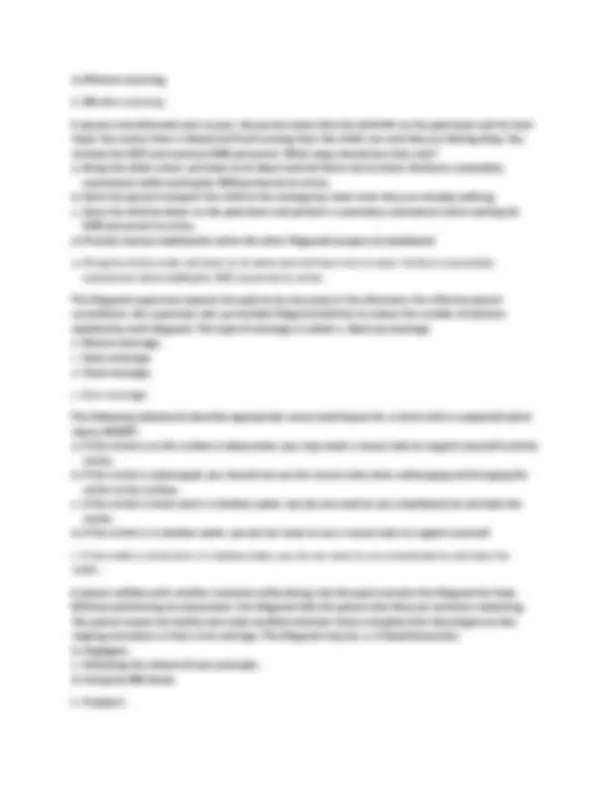
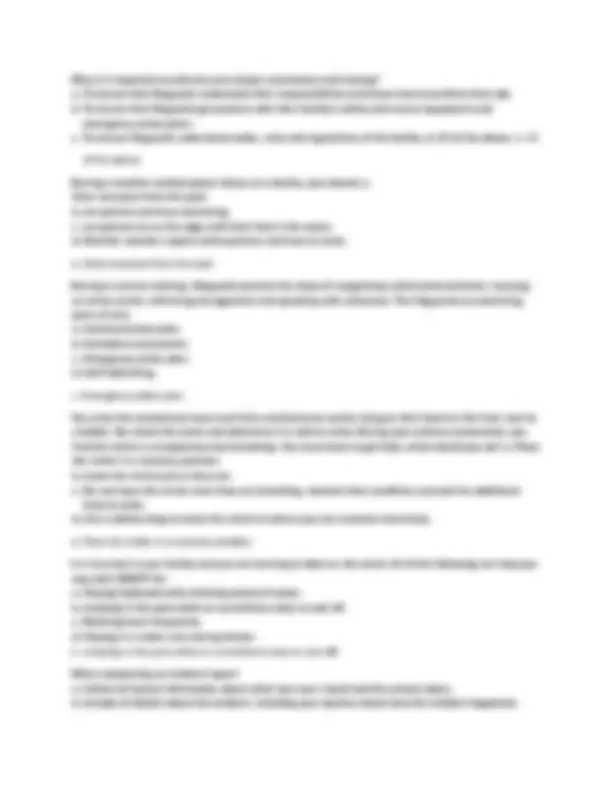
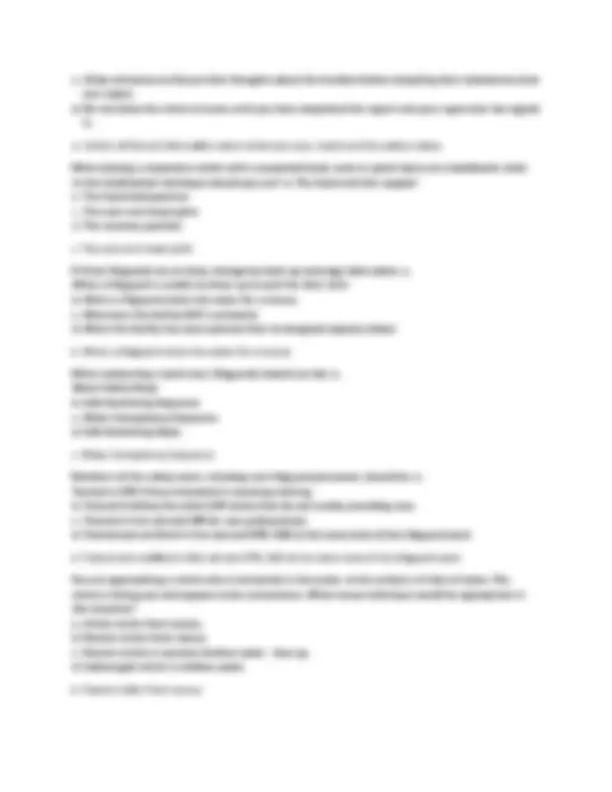
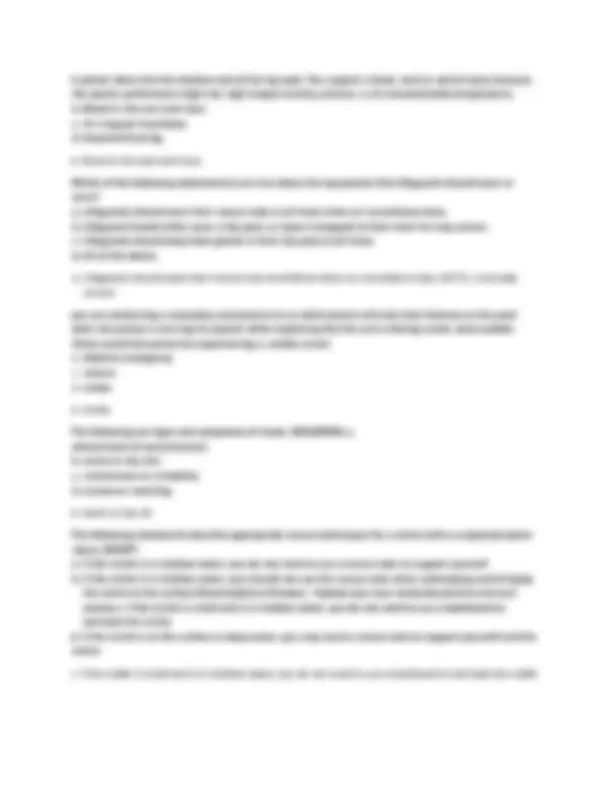


Study with the several resources on Docsity

Earn points by helping other students or get them with a premium plan


Prepare for your exams
Study with the several resources on Docsity

Earn points to download
Earn points by helping other students or get them with a premium plan
Community
Ask the community for help and clear up your study doubts
Discover the best universities in your country according to Docsity users
Free resources
Download our free guides on studying techniques, anxiety management strategies, and thesis advice from Docsity tutors
Adult is unconscious with a pulse but is not breathing. What rate should you perform rescue breathing at? What about for a child and infant? A. 1 breath every 2 seconds for all B. 1 breath every 5 seconds for adults, every 3 seconds for children and infants C. 1 breath every 6 seconds for adults, every 4 seconds for children D. 2 breaths every 10 seconds for all Correct Answer: B Rationale: The correct ventilation rate is 1 every 5 seconds for adults, and 1 every 3 seconds for children and infants to match their faster respiration needs. You pull an adult from the water. They have a pulse but irregular breathing. What should you do first? A. Begin CPR B. Check for internal bleeding C. Give 2 initial ventilations D. Call 911 and wait Correct Answer: C Rationale: Two initial ventilations are given to help clear any water in the airway and initiate breathing.
Typology: Exams
1 / 33

This page cannot be seen from the preview
Don't miss anything!


























Adult is unconscious with a pulse but is not breathing. What rate should you perform rescue breathing at? What about for a child and infant? A. 1 breath every 2 seconds for all B. 1 breath every 5 seconds for adults, every 3 seconds for children and infants C. 1 breath every 6 seconds for adults, every 4 seconds for children D. 2 breaths every 10 seconds for all Correct Answer: B Rationale: The correct ventilation rate is 1 every 5 seconds for adults, and 1 every 3 seconds for children and infants to match their faster respiration needs. You pull an adult from the water. They have a pulse but irregular breathing. What should you do first? A. Begin CPR B. Check for internal bleeding C. Give 2 initial ventilations D. Call 911 and wait Correct Answer: C Rationale: Two initial ventilations are given to help clear any water in the airway and initiate breathing. What are the steps of the Chain of Survival? A. Call 911, Start CPR, Apply Bandage, Transfer Victim B. Early CPR, Defibrillation, Bandaging, EMS Transport C. Recognition, CPR, Defibrillation, ALS, Post-care D. Scene Safety, CPR, AED, Evacuation, Debriefing Correct Answer: C Rationale: These are the five standard steps in the Chain of Survival used in cardiac emergencies. What does LOC stand for? A. Loss of Condition B. Level of Consciousness
C. Line of Care D. Loss of Control Correct Answer: B Rationale: LOC refers to the victim's level of consciousness. H.A.IN.E.S. is used when and stands for what? A. Head And Neck Emergency Support; used for any fall B. High Arm IN Endangered Spine; used if victim with possible spinal injury vomits C. Head Above In Emergency Situation; for unconscious swimmers D. High Alert Incident Emergency System; for backboarding Correct Answer: B Rationale: H.A.IN.E.S. is used to protect the airway of a vomiting victim suspected of having a spinal injury. What does R.I.C.E. stand for and when is it used? A. Run, Ice, Compress, Elevate; for heatstroke B. Rest, Immobilize, Cold, Elevate; for musculoskeletal injuries C. Respond, Ice, Clean, Elevate; for burns D. Recover, Isolate, Cover, Elevate; for bleeding Correct Answer: B Rationale: RICE is the standard first aid procedure for musculoskeletal injuries like sprains or fractures. How do you perform head and chin support? A. One hand on chest, one on chin B. One hand under neck, the other on head C. One hand on chin and arm across chest; the other hand on back of head and arm under back D. Both hands squeezing shoulders Correct Answer: C Rationale: This method stabilizes the spine during water rescues. What is in-line stabilization? A. Rolling the victim over while keeping arms at sides B. Lifting both legs straight C. Arms above head, squeezed together around biceps D. Placing head and neck in straight alignment Correct Answer: C Rationale: In-line stabilization is used to minimize spinal movement during rescues. Steps for deep water submerged victim include: A. Dive to bottom, pull victim up, call EMS B. Compact entry, release tube, support victim, swim back
Correct Answer: C Rationale: Swelling is non-life-threatening and not part of a primary assessment. You are using a resuscitation mask on a child. After positioning the mask, what should you do? A. Remove it B. Seal the mask C. Tilt the head forward D. Start compressions Correct Answer: B Rationale: Proper sealing is required to deliver effective ventilations. As the only rescuer performing CPR on a 7-year-old child, how should you proceed? A. 15 compressions, 1 breath B. 30 compressions, 2 breaths C. 60 compressions, 5 breaths D. 2 compressions, 1 breath Correct Answer: B Rationale: Single-rescuer child CPR follows the same 30:2 ratio as adults. Universal sign of choking in a conscious person? A. Pointing to mouth B. Clutching the throat C. Coughing D. Waving arms Correct Answer: B Rationale: Clutching the throat is a well-recognized universal sign. Patron asks if victim should be moved. What do you say? A. Yes, quickly B. Only if they’re bleeding C. No, not unless there is immediate danger D. Yes, always move to first aid room Correct Answer: C Rationale: Moving a victim unnecessarily can worsen injuries. Best way to protect yourself from bloodborne pathogens? A. Wash hands only B. Use bare hands C. Use PPE (gloves, barrier mask) D. Avoid helping
Correct Answer: C Rationale: PPE protects both rescuer and victim. Slurred speech, one-side facial droop, arm weakness are symptoms of: A. Heart attack B. Stroke C. Choking D. Hypothermia Correct Answer: B Rationale: These are hallmark signs of stroke. You find an unconscious adult with no pulse. What should you do? A. Call EMS and wait B. Begin CPR C. Give 2 ventilations D. Perform Heimlich Correct Answer: B Rationale: CPR is initiated when there is no pulse. Most essential device when giving ventilations to avoid disease? A. Resuscitation mask B. Glove C. Bandage D. AED Correct Answer: A Rationale: Resuscitation masks protect both parties during breathing assistance. Ventilation rate for 5-year-old child with resuscitation mask? A. 1 every 2 seconds B. 1 every 3 seconds C. 1 every 5 seconds D. 2 every 10 seconds Correct Answer: B Rationale: Children require ventilations every 3 seconds. You give a ventilation but the chest doesn’t rise. What do you do? A. Start CPR B. Re-tilt head and try again C. Use an AED D. Stop giving care Correct Answer: B Rationale: Re-tilting may correct an airway obstruction.
What are the steps in the Chain of Survival? A. Call EMS, Begin CPR, Use AED B. Recognition, CPR, Defibrillation, ALS, Post-arrest care C. Defibrillation, EMS arrival, CPR D. CPR, Rescue Breaths, Defibrillation Correct Answer: B Rationale: The five steps of the Chain of Survival are recognition and activation, early CPR, rapid defibrillation, advanced life support (ALS), and post-cardiac arrest care. What does LOC stand for? A. Loss of Care B. Level of Contact C. Level of Consciousness D. Lack of Control Correct Answer: C Rationale: LOC stands for "Level of Consciousness," used to describe a person's awareness and responsiveness. What does H.A.IN.E.S. stand for and when is it used? A. High Alert In Emergency Situations – used during trauma B. Head And Neck Emergency Support – during head injuries C. High Arm IN Endangered Spine – when vomiting with spinal injury D. Heightened Alert In Emergency Systems – used in disaster zones Correct Answer: C Rationale: H.A.IN.E.S. stands for High Arm IN Endangered Spine and is used when a victim with a possible spinal injury begins vomiting, to keep the airway clear while protecting the spine. What does R.I.C.E. stand for and when is it used? A. Rest, Ice, Compression, Elevate – for cardiac care B. Rest, Immobilize, Cold, Elevate – for musculoskeletal injuries C. Reassure, Initiate CPR, Cover, Evacuate – for shock D. Run, Isolate, Call, Exit – during emergencies Correct Answer: B Rationale: R.I.C.E. is the acronym used for musculoskeletal injuries like sprains or fractures: Rest, Immobilize, Cold, and Elevate. How do you perform head and chin support? A. One hand on chest, other on the forehead B. One hand on chin, other hand on back of head, forearms squeeze C. Both hands on shoulders D. One hand stabilizing arm, the other supporting leg Correct Answer: B
Rationale: Proper head and chin support involves stabilizing the head and neck using both forearms to prevent movement. How do you do in-line stabilization in water? A. Hands under neck B. Arm under back, hands on shoulders C. Victim’s arms placed above head and squeezed around biceps D. One hand on head, one on chest Correct Answer: C Rationale: In-line stabilization involves placing the victim’s arms above their head and squeezing around the biceps to align the spine and limit movement. What is the first step when approaching the scene of an emergency? A. Start CPR B. Ask the victim if they're okay C. Size-up the scene while forming an initial impression D. Get an AED Correct Answer: C Rationale: Scene size-up helps ensure your safety, identify hazards, and determine how to proceed with care. What would you check first during a primary assessment? A. Swelling B. Responsiveness C. Pulse D. Bleeding Correct Answer: B Rationale: Responsiveness is checked first to determine if the victim is conscious and alert, which informs the urgency and direction of care. When using an AED, what should you do immediately after attaching the AED pads? A. Begin CPR B. Press the shock button C. Analyze pulse manually D. Tell everyone to stand clear Correct Answer: D Rationale: To avoid injury, it's crucial to ensure that no one is touching the victim when the AED analyzes or delivers a shock. What should you do if a choking victim becomes unresponsive? A. Wait for EMS B. Give abdominal thrusts C. Begin CPR starting with compressions D. Put victim in recovery position
A person has severe life-threatening bleeding and is unresponsive. What is your next step? A. Begin ventilations B. Elevate their legs C. Control the bleeding using available resources D. Wait for EMS Correct Answer: C Rationale: Immediate control of life-threatening bleeding is critical and takes priority in a primary assessment. You are providing care to a conscious infant who is choking. When giving chest thrusts, which technique should you use? A. Use the heel of one hand B. Use 2 or 3 fingers just below the nipple line C. Use both thumbs to squeeze the chest D. Use two fingers on the abdomen Correct Answer: B Rationale: Chest thrusts on an infant should be given with 2 or 3 fingers on the center of the chest, just below the nipple line. During a primary assessment, which of the following should you check first? A. Pulse B. Breathing C. Responsiveness D. Skin color Correct Answer: C Rationale: Responsiveness is checked first to determine if the victim is conscious and to guide your next actions. You are performing CPR on a victim and an assisting responder arrives. What is the most appropriate action for the assisting responder to do first? A. Switch roles with you immediately B. Retrieve a first aid kit C. Check to see whether EMS personnel have been called D. Start rescue breathing Correct Answer: C Rationale: Before assisting with CPR, the new responder should confirm that EMS has been called to ensure professional help is on the way. When giving abdominal thrusts to a conscious choking adult, where should you position your fist? A. On the chest B. On the lower abdomen C. Just above the navel D. Below the rib cage
Correct Answer: C Rationale: Abdominal thrusts should be delivered with the fist placed just above the navel, below the ribcage. Your initial impression reveals severe life-threatening bleeding in an unresponsive adult victim. What should your next step be? A. Perform CPR B. Control the bleeding with available resources C. Begin rescue breaths D. Check for spinal injury Correct Answer: B Rationale: Immediate control of life-threatening bleeding takes priority before CPR in trauma situations. An injured patron is responsive and bleeding. After summoning EMS personnel, obtaining consent, and putting on gloves, what should you do next? A. Begin CPR B. Clean the wound with water C. Press firmly against the wound with a sterile dressing D. Elevate the injured area Correct Answer: C Rationale: Applying firm pressure with a sterile dressing is the best method to control bleeding. What is the first step you should take in caring for a victim with burns? A. Immerse the burn in cold water B. Apply ointment C. Remove the victim from the source of the burn D. Wrap the area in a clean cloth Correct Answer: C Rationale: You must first eliminate the cause of the burn before beginning care. You are providing care to a patron who starts choking and becomes unresponsive. What should you do first? A. Begin rescue breathing B. Give abdominal thrusts C. Call EMS and wait D. Lower the victim to the ground and begin CPR starting with compressions Correct Answer: D Rationale: Once the choking victim becomes unresponsive, CPR should begin immediately to clear the obstruction and restore breathing. You are giving ventilations with a resuscitation mask and the victim vomits. What should you do first?
In the SAMPLE acronym, what does the P stand for? A. Present illness B. Past surgeries C. Pertinent past history D. Physical condition Correct Answer: C Rationale: “P” stands for pertinent past medical history, such as chronic conditions that may affect the current emergency. In the SAMPLE acronym, what does the L stand for? A. Lungs B. Last known well time C. Last oral intake D. Location Correct Answer: C Rationale: “L” refers to the last food or drink the victim consumed, which can be important in diabetic or allergic emergencies. In the SAMPLE acronym, what does the E stand for? A. Emergency contact B. External injury C. Events leading to injury or illness D. Energy level Correct Answer: C Rationale: “E” helps clarify what happened immediately before the incident and gives context to the current situation. You are performing CPR on a victim when you notice the chest begins to rise and fall. What do you do first?
what would lead you to determine that an infant's airway is open and not obstructed? - ANSWER The infant is crying uncontrollably. When giving chest compressions to an adult, how would you position your hands? - ANSWER Heel of one hand on the center of the chest with the other hand on top A 12 yr old child at a swim meet grabs their chest and begins to make wheezing noises. After you obtain consent to provide care, the child's parent informs you that the child has a history of asthma, but doesn;t have an inhaler nearby. What care should you provide? - ANSWER Summon more advanced medical personnel and place the victim into a position that helps breathing. Rate of chest compressions during CPR? - ANSWER 100 BPM (Roughly the tempo of the song "Staying Alive" by the BeeGees. Ironically, it is also the tempo of "Another One Bites The Dust" by Queen. CPR Should be performed on a victim who is... - ANSWER In Cardiac Arrest or unconscious with an obstructed airway. What does the C in C.A.B stand for? - ANSWER Circulation / chest compressions (30) What does the A in C.A.B stand for? - ANSWER Airway (open) What does the B in C.A.B stand for? - ANSWER Breathing / breaths (2) what is C.A.B used for? - ANSWER CPR Hand placement for CPR for an: Adult, Child, Infant - ANSWER Adult and child: Heel of one hand in center of chest (on lower half of sternum) with the other hand on topInfant: 2-3 fingers on center of chest (just below nipple line) Process of using AED - ANSWER Turn on machine. Apply the pads. Plug into machine. Follow instructions. CPR should continue during the setup. Child is choking (conscious). After activating EAP and getting consent from the parents, what should you do next? What about someone unconscious? - ANSWER Stand or kneel behind the victim and give 5 back blows and 5 abdominal thrusts.For unconscious do CPR. Depth of chest compression for CPR for an:Adult, Child, Infant - ANSWER Adult and child: 2 inchesInfant: 1.5 inches
You are providing high-quality CPR on a 6-year-old patient who weighs 44 pounds. The AED arrives. It does not have a pediatric setting and includes only adult AED pads. What should you do? - ANSWER Use the adult AED pads. What is a reason you would choose to perform chest thrusts instead of abdominal thrusts for an adult with an obstructed airway? - ANSWER The patient is in a wheelchair. You and two nurses have been performing CPR on a 72-year-old patient, Ben Phillips. When Mr. Phillips shows signs of ROSC, where should you perform the pulse check? - ANSWER At the carotid or femoral artery You and another provider are caring for a patient who is in cardiac arrest. You suspect that your patient has overdosed on an opioid. When should you administer intranasal naloxone? - ANSWER After initiating CPR You enter Ms. Evers's room and notice her lunch splattered on the floor. She is slumped over the bedside table and does not appear to be breathing. You perform a visual survey and determine that the scene is safe. Which is the next appropriate action? - ANSWER Check for responsiveness. You are alone caring for a 4-month-old infant who has gone into cardiac arrest. Which is the most effective CPR technique to perform until help arrives? - ANSWER Standing to the side of the infant, provide chest compressions using the two-finger technique and deliver ventilations with a pocket mask. How is a child defined in terms of CPR care? - ANSWER Someone from the age of 1 to the onset of puberty You and your colleagues have been providing high-quality CPR for and using the AED on Mr. Sauer. While providing ventilations, you notice that Mr. Sauer moves and appears to be breathing. What is the correct course of action? - ANSWER Stop CPR, check for breathing and a pulse and monitor Mr. Sauer until the advanced cardiac life support team takes over. You are providing compressions on a 6-month-old who weighs 17 pounds. Which compression depth is appropriate for this patient? - ANSWER About 1½ inches You are alone and caring for a 9-month-old infant with an obstructed airway who becomes unresponsive. Which action should you perform first? - ANSWER Provide 30 chest compressions. You perform a rapid assessment and determine that your patient is experiencing cardiac arrest. On the basis of your assessment findings, you begin CPR to improve the
patient's chances of survival. Which term refers to clearly and rationally identifying the connection between information and actions? - ANSWER Critical thinking Upon entering Mr. Cohen's room, you find him on the ground, unresponsive. After immediately initiating the emergency response system, what is your next action according to the Adult In-Hospital Cardiac Chain of Survival? - ANSWER Early CPR During a resuscitation, the team leader assigns team roles and tasks to each member. You recognize that a task has been overlooked. Which is the most appropriate action? - ANSWER Alert the team leader immediately and identify for them what task has been overlooked. A 7-year-old patient goes into sudden cardiac arrest. You initiate CPR and correctly perform chest compressions at which rate? - ANSWER 100 to 120 compressions per minute How long does it take for brain damage or death to occur? - ANSWER 4-6 mins Primary Responsibility: - ANSWER to prevent drowning Examples of Primary Responsibilities: - ANSWER Monitoring activities in and near the water, Enforcing facility rules Secondary responsibilities should.... - ANSWER Never interfere with primary responsibilities Examples of secondary responsibilities: - ANSWER Testing pool water, maintenance In a life guard stand you should always... - ANSWER Be alert and ready to respond in an athletic position and not be eating define FIND - ANSWER F- Figure out the problem I- Identify possible solutions, N- Name the pros and cons for each solution, D- Decide which solution is best and act upon it When should FIND be used? - ANSWER To make decisions on how to deal with the problem in NON EMERGENCY situations Duty to act- - ANSWER While on the job you have a legal responsibility to act in an emergency. Failure to adhere to this duty could result in legal action What does EAP stand for? - ANSWER Emergency Action plan
Drowning victim- Active - ANSWER May not be able to call for help, efforts focused on breathing, May be horizontal face down, extended arms, positioned vertically in the water Drowning Victim- Passive - ANSWER Can't ask for help, submerged, limp (dead weight), not breathing Distressed swimmer - ANSWER above water, clinging to side, is breathing, no forward progress, able to call for help, at surface RID - ANSWER R- Recognition, I-Intrusion, D- Distraction Zone coverage - ANSWER Multiple zones Total coverage - ANSWER One whole zone (the entire pool) Emergency back up coverage - ANSWER when one life guard has to rescue, the other takes over two zones Risk Management - ANSWER identifying dangerous behaviors and eliminating them Preventive Lifeguarding - ANSWER trying to make sure injuries don't happen in the first place procedures for water emergency: - ANSWER EAP, Enter water if necessary, perform rescue, move victim to safe point to exit, remove victim from water, provide care, Report advise release Reaching assist: - ANSWER With the tube put it in water and tell them to grab it Simple assist: - ANSWER Help them stand in shallow water Head Neck and Spinal injuries... - ANSWER Rarely happen during supervised diving into deep water, most often occur at the shallow end in a corner where the bottom slopes person while diving. Head neck or spinal injuries in water procedure: - ANSWER EAP, Enter water, move victim to safety, Check for responsiveness and breathing, RE asses the victims condition and provide appropriate care A 12-year-old child at a swim meet grabs their chest and begins to make wheezing noises. After you obtain consent to provide care, the child's parent informs you that the child has a history of asthma, but does not have an inhaler nearby. What care should you provide? a. Give 5 back blows. b. Summon more advanced medical personnel and place the victim into a position that helps breathing.
c. Tell the victim to use an inhaler borrowed from a bystander. d. Wait 20 minutes to see if the breathing difficulty goes away. b. Summon more advanced medical personnel and place the victim into a position that helps breathing. Your initial impression of a victim is based on: a. The victim's initial vital signs. b. How the victim appears to you as you size up the scene. c. The victim's SAMPLE history. d. What you have been told about the victim. b. How the victim appears to you as you size up the scene. You and another lifeguard find an unresponsive adult on the floor in the locker room. You activate your facility's EAP, size-up the scene, form an initial impression and perform a primary assessment. You find the victim is not moving or breathing, but has a pulse. You should summon EMS personnel, then: a. Give ventilations at a rate of one breath every 5-6 seconds. b. Give back blows and chest thrusts. c. Give quick breaths at the rate of 20 to 40 a minute. d. Perform CPR. a. Give ventilations at a rate of 1about every 5-6 seconds. You arrive on the scene where a patron appears to be injured. Before approaching the victim, which of the following will you NOT do as you size-up the scene? a. Begin performing the primary assessment. b. Use all your senses to determine if the scene is safe. c. Form an initial impression. d. Put on appropriate PPE. a. Begin performing the primary assessment. When providing care during an emergency, which of the following should you do first? a. Size-up the scene while forming an initial impression. b. Check for responsiveness. c. Perform a primary assessment. d. Summon more advanced medical personnel. a. Size-up the scene while forming an initial impression. As the first rescuer on the scene, you are performing CPR on an adult. When performing chest compressions, how deeply should you compress the chest? a. About 2 inches b. At least 2 inches but no more than 2.4 inches c. About 1½ inches d. At least 1 inch but no more than 2 inches b. At least 2 inches but no more than 2.4 inches CPR should be performed on which of the following victims? a. One who is in cardiac arrest